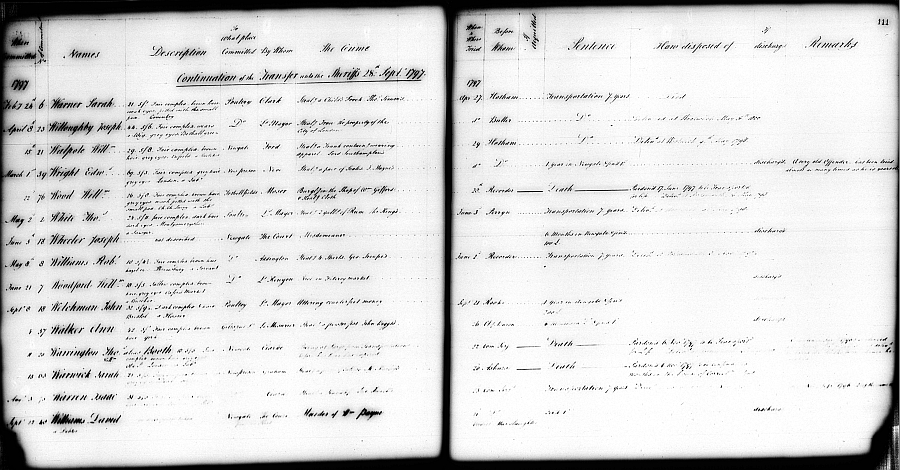Criminal Registers of Prisoners in Middlesex and the City (CR)
 Home Office, Criminal Registers – Series 1, Newgate, etc., 1791-1801, National Archives, Ms HO26, LL ref: NAHOCR700030184&5
Home Office, Criminal Registers – Series 1, Newgate, etc., 1791-1801, National Archives, Ms HO26, LL ref: NAHOCR700030184&5
Introduction
The Criminal Registers were first created in 1791 and covered the county of Middlesex and the City of London only. The registers were created in response to the perception of rising crime rates in the late 1780s, and form a significant starting point in the evolution of a consistent national records system for tracking those accused of crimes. The inclusion of physical descriptions in these registers marks a new departure in contemporary thinking about the information that was needed to fight crime.1
In the nineteenth century the Registers were extended to the rest of the country. Reproduced on this website are images and transcriptions of the first nine years covered by this source.2
Layout and Content
The eighteenth-century Registers take the form of an alphabetically organised list of prisoners held at Newgate Prison, most of whom were tried at at the Old Bailey. As a result most individuals listed in the Registers also appear in the Old Bailey Proceedings. The information recorded in the Registers includes the name of the accused, the date they were imprisoned, a physical description, place of birth, and a brief description of the crime of which they were accused. The date and location of the trial, the sentence meted out and the prisoner's date of discharge or death are also recorded.
The registers take the form of a two-page table, with the name in the left hand column, and the other information entered from left to right.
Because this table format does not reproduce well in transcription, it is best to look at the original page images.
Introductory Reading
- Hawkings, D. T. Criminal Ancestors: A Guide to Historical Criminal Records in England and Wales. Stroud, 1992, pp. 35-43.
- King, Peter. Crime and Law in England 1750-1850. Remaking Justice from the Margins. Cambridge, 2006.
Online Resources
- The National Archives
- Access to Archives Criminal Registers (CR)
For further reading on this subject see the London Lives Bibliography.
Documents Included on this Website
- Home Office, Criminal Registers – Series 1, Newgate, etc., 1794, National Archives, Ms. HO26/3, LL ref: NAHOCR70000, Tagging Level: D
- Home Office, Criminal Registers – Series 1, Newgate, etc., 1794-95, National Archives, Ms. HO26/4, LL ref: NAHOCR70001, Tagging Level: D
- Home Office, Criminal Registers – Series 1, Newgate, etc., 1796-97, National Archives, Ms. HO26/5, LL ref: NAHOCR70002, Tagging Level: D
- Home Office, Criminal Registers – Series 1, Newgate, etc., 1797-98, National Archives, Ms. HO26/6, LL ref: NAHOCR70003, Tagging Level: D
- Home Office, Criminal Registers – Series 1, Newgate, etc., 1800-01, National Archives, Ms. HO26/7, LL ref: NAHOCR70004, Tagging Level: D
- Home Office, Criminal Registers – Series 1, Newgate, etc., 1791-92, National Archives, Ms. HO26/1, LL ref: NAHOCR70005, Tagging Level: D
- Home Office, Criminal Registers – Series 1, Newgate, etc., 1792-93, National Archives, Ms. HO26/2, LL ref: NAHOCR70006, Tagging Level: D
- Home Office, Criminal Registers – Series 1, Newgate, etc., 1793-94, National Archives, Ms. HO26/3, LL ref: NAHOCR70007, Tagging Level: D
Back to Top | Introductory Reading
Footnotes
1 For a wonderful exploration of the ways in which the creation of the Criminal Registers impacted on a single individual criminal, see Mary Clayton, The Life and Crimes of Charlotte Walker, Prostitute and Pickpocket, London Journal, 33:1 (2008), pp. 3-19. ⇑
2 For a clear outline of the evolution of the registers as a series of documents see D.T. Hawkings, Criminal Ancestors: A Guide to Historical Criminal Records in England and Wales (Stroud, 1992), pp. 35-43. ⇑